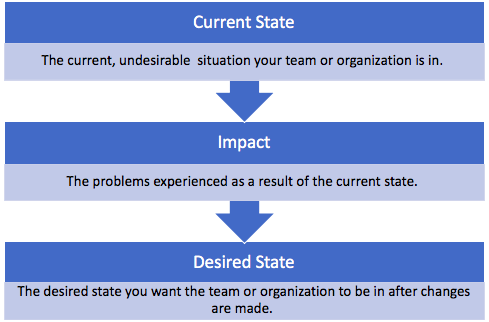
When you set out on a problem-solving effort, it’s important to be clear about the problem you’re going to solve. Even if the whole team knows there’s a problem, you can’t be sure you’re all focused on solving the same problem until everyone comes to an agreement on just what the problem is.
Here’s an example of what I mean….
Your team wants to undertake a problem-solving effort because they’re working long hours handling a large number of customer support calls, in addition to their regular duties.
Before you examine the situation more closely, different people on the team may have different ideas about the real problem you’re all going to focus on.
Jane may think you’re focused on working faster.
Stan may think you’re going to solve the problem of being short-staffed and try to hire more people to fix bugs in the software.
And Emily might think you’re all going to focus on how to hire more help desk staff to answer the callers’ questions.
But after conducting a 5 Whys Root Cause Analysis, you all realize and agree the support calls are from users who have just adopted new software you’ve rolled out. It seems they all have questions on how to perform certain functions in the software.
Your problem appears to be a training issue.
So your opportunity would likely be focused on providing some form of additional training for those new software users.
And by crafting a clear opportunity statement, you ensure everyone involved has a clear picture of the reasons why you’ll be creating and delivering the related software training.
What is an Opportunity Statement?
An opportunity statement is a carefully crafted explanation of the current undesirable situation, its impacts, and the ideal state you prefer instead.
Clearly state what situation you’re dealing with, why it’s a problem, and what your ideal state would be.
Benefits of Using It In the Problem-Solving Process

Crafting a clear opportunity statement is a valuable step in the problem-solving process.
It will help you clearly communicate the challenge you’re addressing and the change you want to see.
There are several benefits to crafting an opportunity statement. By crafting a clear opportunity statement, you:
- clarify your understanding of the situation you’re dealing with.
- more clearly communicate the situation with others
- are more likely to get buy-in on the need to solve the problem.
How to Craft your Opportunity Statement
Follow this simple formula to create your opportunity statement:
Current State – the current situation your team or organization is experiencing.
Impact – the impact this is causing for the team, or the problems you’re experiencing as a result of the current state.
Desired State – the desired state you want the team or organization to be in after changes are made. This is what you’re working toward. If you can quantify your desired state, go ahead and do so.
For example, you want to reduce error rates by 50% in three months, or you want to increase enterprise-wide compliance to 95% by June 30, 2020.

Example Opportunity Statement
Current State – The lighting along the walkways to the parking garage is poor. Additionally, there is very limited lighting around and in the parking garage. There are also no security cameras or security personnel regularly monitoring that area.
Impact – As a result, staff members insist on leaving work before dark, claiming they feel unsafe. This results in less work being completed and over time the teams fall behind on work.
Additionally, personnel request security staff to accompany them to their cars if they do need to walk to their cars after dark. This causes the front desk to be short-staffed of security coverage.
Also, there have been several falls and injuries by staff walking to their cars after dark.
This all also results in lower morale and an overall perception that staff safety is not a priority.
Desired State – The outdoor walkways to the parking garage are well-lit and easy to navigate in the evenings and at night. The parking garage is well-lit, and security cameras are installed as an additional safety measure. The staff members feel safe and comfortable walking to their cars at the end of the day, even during the shortened daylight seasons.
As you can see, this Opportunity Statement makes it clear to all what the problem is, how it negatively impacts the workplace in multiple ways, and what the ideal situation would look once corrected.
Helpful tips
- Don’t include the cause of the problem. In the opening example, you wouldn’t explain why training wasn’t provided initially.
- Don’t include solutions or how you’ll address the problem. In the opening example, you wouldn’t include how you’ll deliver the training as part of the opportunity statement.
- Focus on only one problem. Don’t address multiple problems in your opportunity statement.
- Determine and craft a desired state that’s attainable. Don’t go for “pie-in-the-sky” rainbows and unicorns if your team can’t achieve that. Determine the desired state that your team can successfully work toward.
The post How to Write a Clear Opportunity Statement for Better Problem-Solving appeared first on Project Bliss.